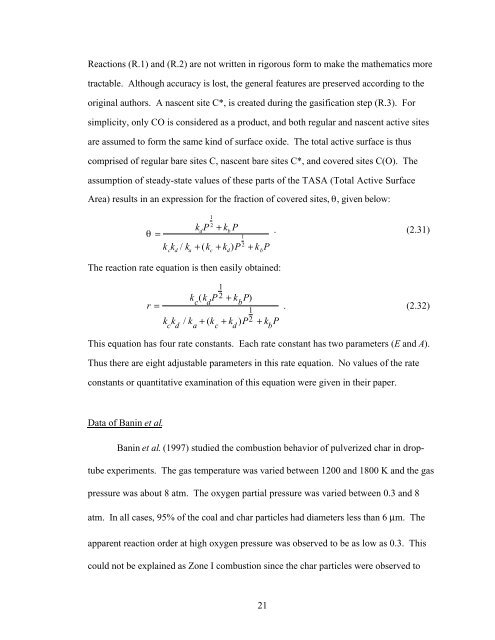MODELING CHAR OXIDATION AS A FUNCTION OF PRESSURE ...
MODELING CHAR OXIDATION AS A FUNCTION OF PRESSURE ...
MODELING CHAR OXIDATION AS A FUNCTION OF PRESSURE ...
You also want an ePaper? Increase the reach of your titles
YUMPU automatically turns print PDFs into web optimized ePapers that Google loves.
Reactions (R.1) and (R.2) are not written in rigorous form to make the mathematics more<br />
tractable. Although accuracy is lost, the general features are preserved according to the<br />
original authors. A nascent site C*, is created during the gasification step (R.3). For<br />
simplicity, only CO is considered as a product, and both regular and nascent active sites<br />
are assumed to form the same kind of surface oxide. The total active surface is thus<br />
comprised of regular bare sites C, nascent bare sites C*, and covered sites C(O). The<br />
assumption of steady-state values of these parts of the T<strong>AS</strong>A (Total Active Surface<br />
Area) results in an expression for the fraction of covered sites, , given below:<br />
=<br />
1<br />
2 kdP + kb P<br />
1<br />
2 k ckd / ka + (kc + kd )P + k bP . (2.31)<br />
The reaction rate equation is then easily obtained:<br />
r =<br />
1<br />
k<br />
c<br />
(k<br />
d<br />
P 2 + kbP) 1<br />
k<br />
c<br />
k<br />
d<br />
/ k<br />
a<br />
+ (k<br />
c<br />
+ k<br />
d<br />
)P2<br />
+ kbP 21<br />
. (2.32)<br />
This equation has four rate constants. Each rate constant has two parameters (E and A).<br />
Thus there are eight adjustable parameters in this rate equation. No values of the rate<br />
constants or quantitative examination of this equation were given in their paper.<br />
Data of Banin et al.<br />
Banin et al. (1997) studied the combustion behavior of pulverized char in drop-<br />
tube experiments. The gas temperature was varied between 1200 and 1800 K and the gas<br />
pressure was about 8 atm. The oxygen partial pressure was varied between 0.3 and 8<br />
atm. In all cases, 95% of the coal and char particles had diameters less than 6 μm. The<br />
apparent reaction order at high oxygen pressure was observed to be as low as 0.3. This<br />
could not be explained as Zone I combustion since the char particles were observed to
















